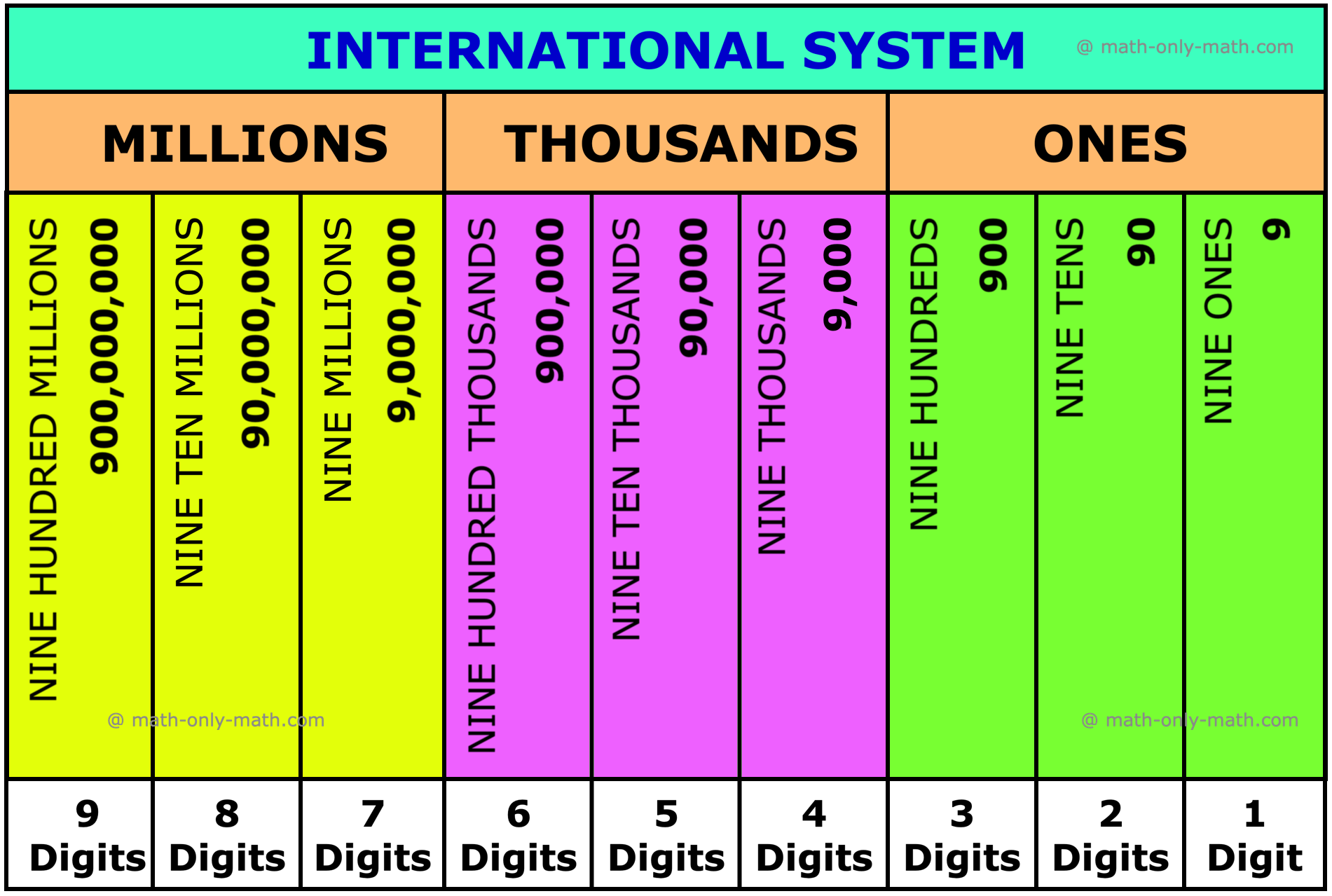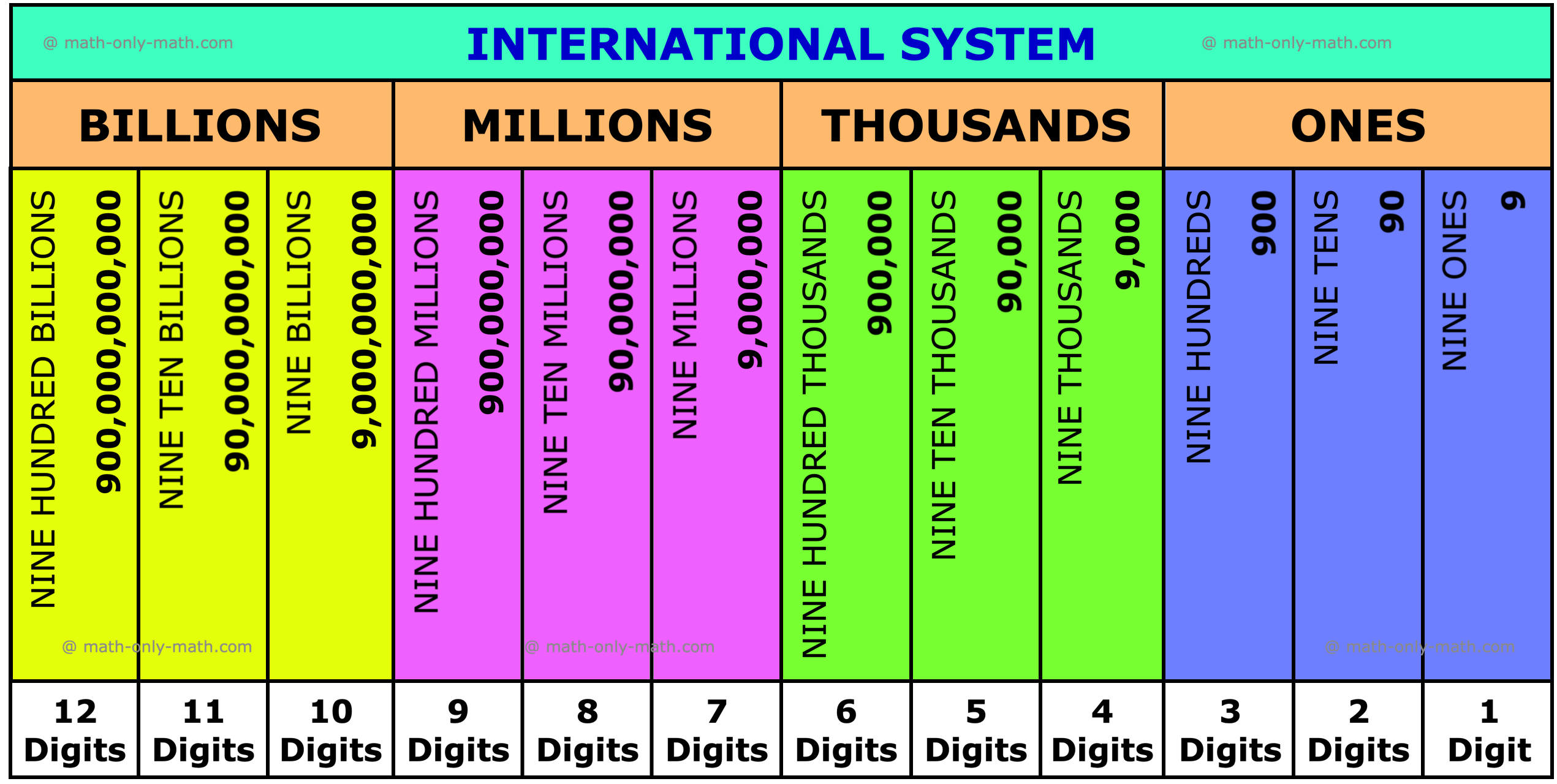Subscribe to our ▶️ YouTube channel 🔴 for the latest videos, updates, and tips.
International Numbering System
In International numbering system also, we form different periods to read the large numbers easily. Here we use periods like ones, thousand and millions etc.
Suppose, let us understand the International system by using number 1: ones (1), tens (10), hundreds (100), one thousands (1000), ten thousands (10000), hundred thousands (100,000), one millions (1,000,000), ten millions (10,000,000), hundred millions (100,000,000), etc. Here we place the numbers according to their place value.
In International system also, we put a comma (,) after each periods to differentiate the periods.
Some examples will help us to write the International numbering system in figures and in words.
In International system, so far we have learnt about numbers up to millions. In International system we have periods like millions, thousands and ones.
Now we will learn about numbers beyond millions.
We can understand expressing large numbers more clearly with the help of the given table.
Suppose, we have to express the number 3685964971 in the International system.
We express it as 3,685,964,971.
We read it as three billion, six hundred and eighty-five million, nine hundred and sixty-four thousand, nine hundred and seventy-one.
Similarly, we can express the numbers in ten billions and hundred billions.
12,016,140,304 is expressed as twelve billion, sixteen million, one hundred and forty thousand, three hundred and four.
116,216,410,618 can be expressed as one hundred and sixteen billion, two hundred and sixteen million, four hundred and ten thousand, six hundred and eighteen.
Solved Examples on International Numbering System:
1. Write the following in figures in the international system:
(i) Five thousand
(ii) Fifty thousand
(iii) Five hundred thousand
(iv) Five million
(v) Fifty million
(vi) Five hundred million
Solution:
(i) 5,000
(ii) 50,000
(iii) 500,000
(iv) 5,000,000
(v) 50,000,000
(vi) 500,000,000
Note:
• The first period, called ones period, is formed with the first 3 digits of the number.
• The second period, called thousands period, is formed with the next 3 digits of the number.
• The third period, called millions period, is formed with the digits after thousands.
2. Write the following in figures in the International system:
(i) five thousand, two hundred and twenty
(ii) Twenty-two thousand, five hundred and eleven
(iii) Three hundred and twenty-five thousand, four hundred and two
(iv) Four million, one hundred and thirty-two thousand, three hundred and sixteen
(v) Twenty-five million, two hundred and twelve thousand, four hundred and twenty-three
(vi) Three hundred and fifteen million, one hundred and twenty-one thousand, eight hundred and ten
Solution:
(i) 5,220
(ii) 22,511
(iii) 325,402
(iv) 4,132,316
(v) 25,212,423
(vi) 315,121,810
Note:
In the international numbering system, we write millions after thousands while in the Indian system, we write lakhs after thousands.
Worksheet on International Numbering System:
1. Insert comma (,) to express the following numbers in the International system.
(i) 3542468710
(ii) 59948412500
(iii) 25469830710
(iv) 90843654291
(v) 296342582092
(vi) 625398100365
(vii) 543826138120
(viii) 432962384314
Answer:
1. (i) 3,542,468,710
(ii) 59,948,412,500
(iii) 25,469,830,710
(iv) 90,843,654,291
(v) 296,342,582,092
(vi) 625,398,100,365
(vii) 543,826,138,120
(viii) 432,962,384,314
2. Write the number names of the following in the International system.
(i) 8,364,592,043
(ii) 20,318,420,031
(iii) 1,648,532,154
(iv) 12,284,563,908
(v) 242,006,843,901
(vi) 980,043,529,125
(vii) 421,683,459,432
(viii) 952,964,394,251
Answer:
2. (i) Eight billion, three hundred and sixty-four million, five hundred and ninety-two thousand and forty-three
(ii) Twenty billion, three hundred and eighteen million, four hundred and twenty thousand and thirty-one
(iii) One billion, six hundred and forty-eight million, five hundred and thirty-two thousand, one hundred and fifty-four
(iv) Twelve billion, two hundred and eighty-four million, five hundred and sixty-three thousand, nine hundred and eight
(v) Two hundred and forty-two billion, six million, eight hundred and forty-three thousand, nine hundred and one
(vi) Nine hundred and eighty billion, forty-three million, five hundred and twenty-nine thousand, one hundred and twenty-five
(vii) Four hundred and twenty-one billion, six hundred and eighty. three million, four hundred and fifty-nine thousand, four hundred and thirty-two
(viii) Nine hundred and fifty-two billion, nine hundred and sixty-four million, three hundred and ninety-four thousand, two hundred and fifty-one
From International Numbering System to HOME PAGE
Didn't find what you were looking for? Or want to know more information about Math Only Math. Use this Google Search to find what you need.




New! Comments
Have your say about what you just read! Leave me a comment in the box below. Ask a Question or Answer a Question.